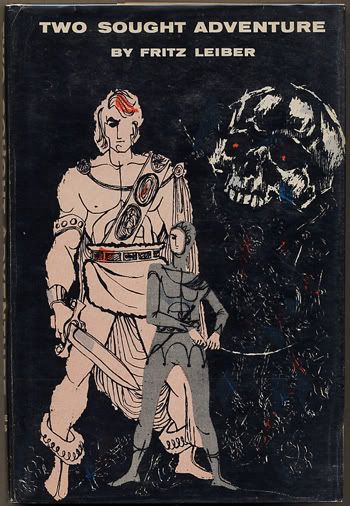The Big Three of Heroic Fantasy, Part One: Fritz Leiber, and Fafhrd & the Gray Mouser
After my initial discovery of heroic fantasy, via The Hobbit and Dungeons & Dragons, my next step was borrowing the books of Fritz Leiber from one of our local libraries. Now, I can't remember what, exactly, brought me to the tales of Fafhrd and the Gray Mouser before Conan or Elric, or other of the usual suspects. Maybe it was because there were two heroes instead of just one. Maybe it was the cover art. Maybe the library just had the whole series on its shelves. Whatever the initial draw, I know what hooked me.

Leiber's Fafhrd and the Gray Mouser stories are some of the most essential to determining the further shape of popular fantasy fiction in the late 20th century. There are many writers working in the same period (the 1940s, 50s and 60s, primarily) who did much more boundary-pushing, who ranged further in terms of setting or exotic definitions of magic, or exploration of bizarre inhuman cultures. But Leiber did something more important: he helped establish the boundaries. If you look at a "generic" fantasy setting today, any setting that is meant to be either easily accessible, or perhaps iconically recognizable, you're looking at one part Tolkien's Middle Earth and one part Leiber's Nehwon, perhaps through a filter of Gygax. This is, by and large, the Pure Stuff.
The first F&GM story ever published was "Two Sought Adventure" in a 1939 issue of Unknown. The characters were devised by Leiber and his friend, Harry Otto Fischer, in a series of letters exchanged during the 1930's. Fafhrd, the tall, pale Northern warrior was apparently patterned on Leiber, and the small, dark urban rogue Mouser was based on Fischer. Fischer was not a professional writer, but he is credited with the first portion of the story "the Lords of Quarmall", finished by Leiber, as well as a short tale called "The Childhood and Youth of the Gray Mouser", published in an early issue of Dragon magazine. (Leiber and Fischer also created a tabletop wargame, based on the world of Nehwon, a year before the first story was published. Later on, a simplified version was published as a boardgame called "Lankhmar," via TSR Games. )
The first collection of Fafhrd & Gray Mouser stories was also titled "Two Sought Adventure", published in 1957. The more familiar editions, however, were the re-arranged and sometimes re-edited "Swords" series of the 1970s onward. As was fashionable at the time, following the belated success of "The Lord of the Rings", the works of heroic fantasy authors who worked primarily in short stories were assembled into de facto epic sagas. Fafhrd & Mouser's adventures were assembled into a series of (eventually) seven volumes, starting in 1968 with volumes 3 through 5 (collecting mostly stories written during the 1960s), Then volumes 1 and 2 in 1970 (stories both recent, and older, with the bulk of volume 2 made up by the contents of "Two Sought Adventure"). A sixth volume followed in 1977, and a seventh in 1988. Leiber himself passed away in 1992.

The stories were arranged according to internal chronology, which can lead to slightly jarring changes in style, as at the start of the second volume, "Swords Against Death", where a piece from 1970 is followed by a tonally and stylistically different item from 1939. Further, some of the pieces, particularly from the first two volumes, are mainly intended to bridge the continuity gaps caused by adding prequel stories some 3 decades after the fact. All in all, the approach I'll take to reviewing the books will be the same as the approach I took to re-reading them; they'll be treated as anthologies of distinct and separate stories, rather than as post-hoc novels.
Leiber's other notable works, aside from the series at hand, include several Hugo and/or Nebula award winners ("The Big Time", "The Wanderer"), the World Fantasy Award-winning novel "Our Lady of Darkness", and the thrice-filmed "Conjure Wife" ("Weird Woman", 1944, with Lon Chaney Jr, "Night of the Eagle", 1962, with Peter Wyngarde, and "Witch's Brew", 1980, with Teri Garr).
Coming up: Reviews of the stories from "Swords and Deviltry"